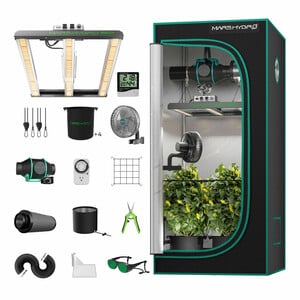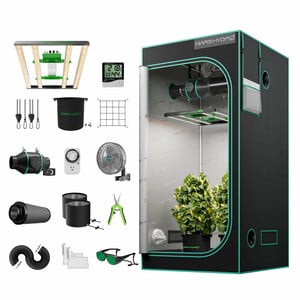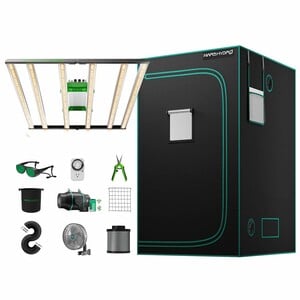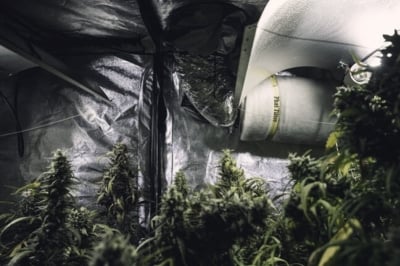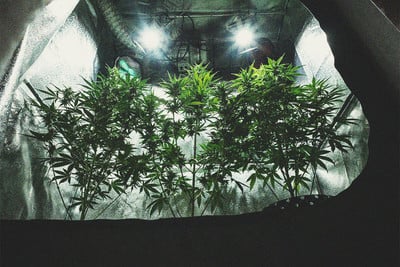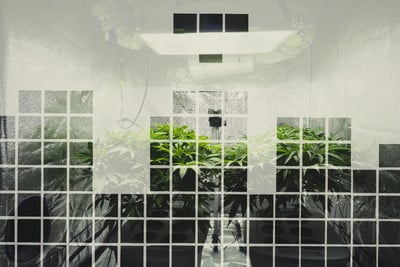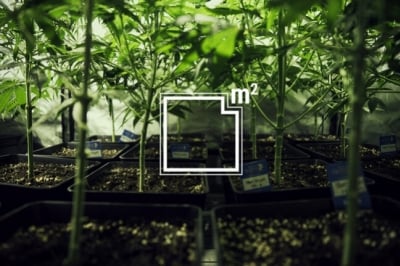.
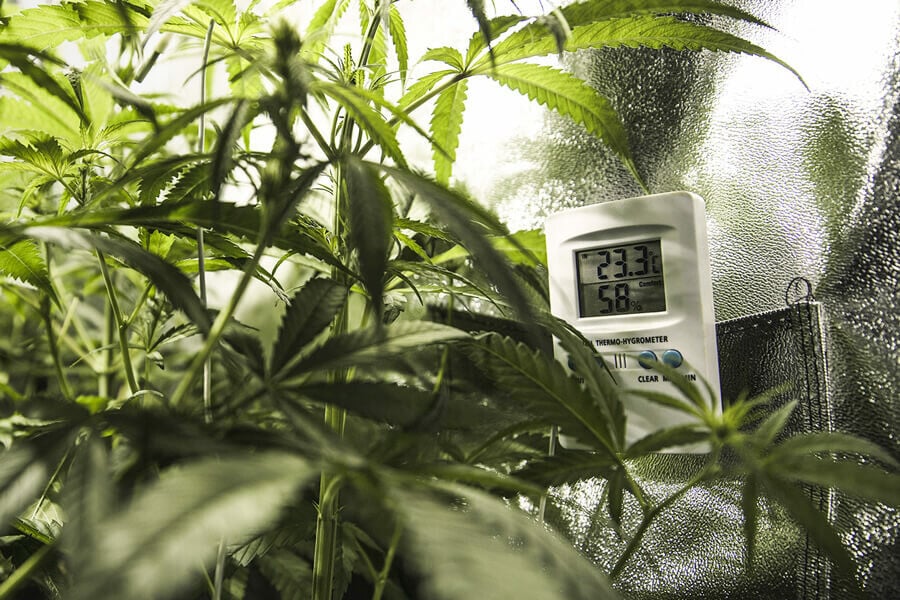
What Is the Ideal Grow Tent Temperature and Humidity?
Temperature and humidity might not be the most exciting factors of your grow, but they are essential when it comes to cultivating high-quality weed indoors. Here's everything you need to know to create the perfect environment for your crop!
Contents:
- Grow tent temperature and humidity basics
- What temperature and humidity should my grow tent be?
- How to lower humidity in a grow tent
- How to increase humidity in a grow tent
- Grow tent temperature control
- Advanced tips for temperature and humidity management
- Temperature and humidity: two key metrics in cannabis growing
Key Points
- Temperature and humidity play a significant role in growing cannabis.
- When these variables are not properly managed, plants grow slowly and produce poor yields.
- Excessively high or low temperature and humidity increase the odds of diseases, pests, and damage to foliage.
- Learn how to perfect these variables below for the best harvests possible.
It’s easy to get obsessed with lights and nutrients when growing weed, but equally important are temperature and humidity. These two factors control a host of different essential plant processes, and also make the occurrence of pests and diseases more or less likely. So they’re not to be overlooked!
Here, we’re looking in depth at what your plants need regarding these two environmental factors, and how to give it to them. At the end, we’ll look at some advanced techniques for growers who want to take environmental control to the next level.
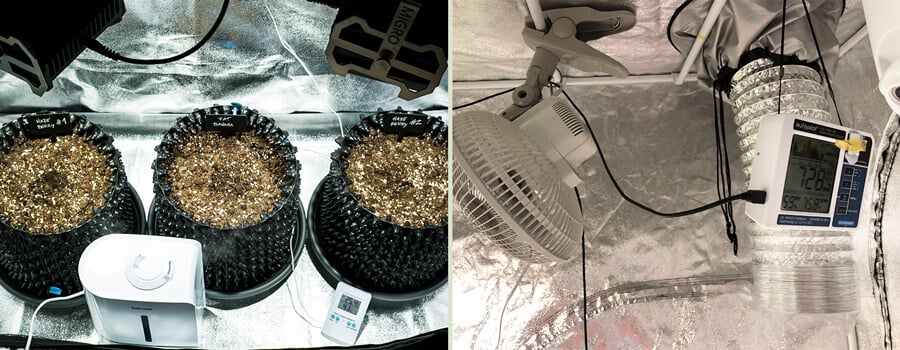
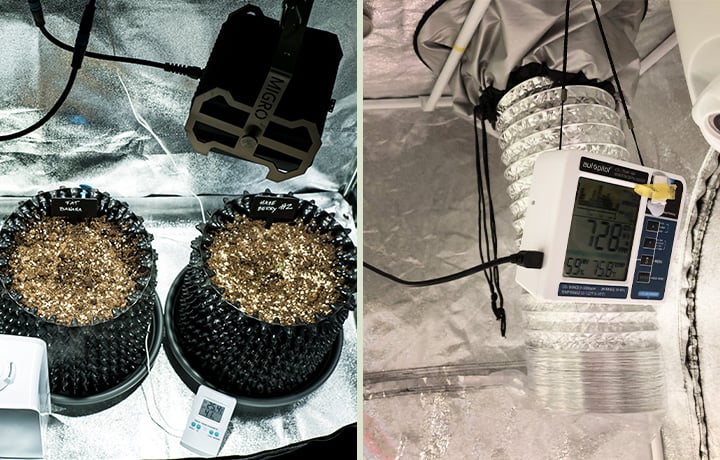
Grow Tent Temperature and Humidity Basics
Like all living beings, cannabis plants have evolved to flourish in certain conditions, and the closer you can imitate these conditions in the grow room, the better results you’ll get come harvest time. Weed is a hardy plant and can grow in less-than-perfect settings; however, if you want to harvest huge, potent flowers, then you’ll need to know how to give your crop what it really longs for.
In the following sections, we’ll look at the ideal climate for cannabis plants at different stages during their life cycle.
-
Why Temperature and Humidity Matter for Plant Growth
Temperature and humidity affect cannabis plants in two main ways. First, these factors influence the processes that occur within the plants themselves, such as photosynthesis, respiration, nutrient uptake, transpiration, and water retention. Basically all of their bodily processes are influenced by these two factors to some degree—much like our own.
Second, temperature and humidity also affect what grows (and what doesn’t) in the surrounding environment. So a hot, humid grow space is also the perfect space for certain fungi and bacteria to develop, which can lead to infection and disease for your plants.
So it’s all about finding a perfect balance in which your plants are happy but the environment isn’t too hospitable to pests. Here’s what you need to bear in mind when it comes to balancing the environment:
- High humidity promotes mould, mildew, and root rot.
- Low humidity causes stunted growth, nutrient deficiencies, and water stress.
- Extreme temperatures can lead to plant stress, slower growth, or structural damage.
-
Grow Room Temp and Humidity Chart
| GROWTH STAGE | TEMP (DAY) | TEMP (NIGHT) | HUMIDITY (%) |
| Seedling | 20–25°C (68–77°F) | 18–22°C (64–71°F) | 65–70 |
| Vegetative | 22–28°C (72–82°F) | 20–24°C (68–75°F) | 50–70 |
| Flowering | 20–26°C (68–79°F) | 18–22°C (64–71°F) | 40–50 |
| Drying / Curing | 18–20°C (64–68°F) | - | 45–55 |
| SEEDLING | |
|---|---|
| TEMPERATURE (DAY | 20–25°C (68–77°F) |
| TEMPERATURE (NIGHT) | 18–22°C (64–71°F) |
| HUMIDITY (%) | 65–70 |
| VEGETATIVE | |
|---|---|
| TEMPERATURE (DAY | 22–28°C (72–82°F) |
| TEMPERATURE (NIGHT) | 20–24°C (68–75°F) |
| HUMIDITY (%) | 50–70 |
| FLOWERING | |
|---|---|
| TEMPERATURE (DAY | 20–26°C (68–79°F) |
| TEMPERATURE (NIGHT) | 18–22°C (64–71°F) |
| HUMIDITY (%) | 40–50 |
| DRYING / CURING | |
|---|---|
| TEMPERATURE (DAY | 18–20°C (64–68°F) |
| TEMPERATURE (NIGHT) | - |
| HUMIDITY (%) | 45–55 |
What Temperature and Humidity Should My Grow Tent Be?
Ideally, your grow tent will be at a different temperature at night than it is during the day. If you can, then you should follow the chart above as closely as possible to fine-tune the environment to your plants’ needs. If you’re not able to be so precise, then you should nevertheless aim for the tent to be cooler at night than in the day.
During the night, somewhere between 18 and 22ºC will be appropriate (with 20ºC being a good average for the whole grow), and during the day somewhere between 22 and 26ºC would be appropriate for the entire period.
This is all very general, and certain strains have specific requirements. For instance, thanks to their ruderalis genetics, autoflowers can tolerate wider temperature and humidity ranges without suffering. Photoperiods, on the other hand, particularly sativas from tropical climates, have much more specific requirements and need carefully managed environments for optimal results.
Regarding humidity, in the context of cannabis cultivation, we're really talking about relative humidity (RH). This is simply a measure of how much moisture is in the air at a specific temperature compared to the maximum amount it can hold.
During the veg cycle, plants can handle a fairly high RH, but during flowering, the RH must be dramatically reduced to prevent the buds from developing mould or experiencing any other form of infection or infestation. When adjusting RH, it’s best to do it gradually over time so that your plants can acclimate.
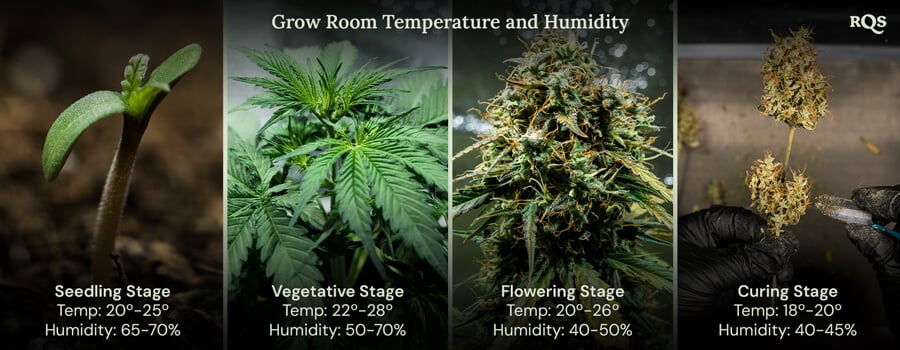
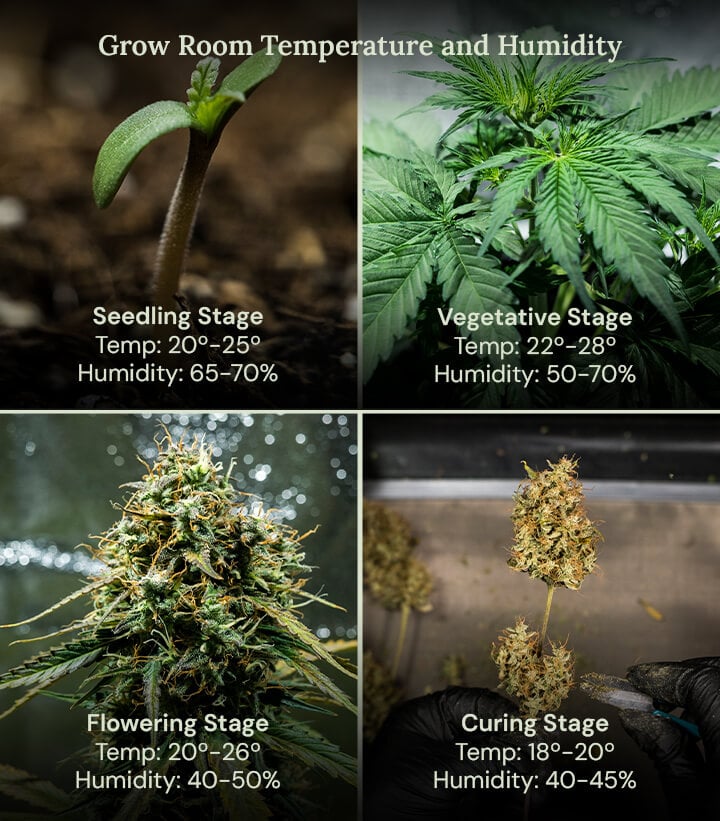
How to Lower Humidity in a Grow Tent
In grow tents and small grow rooms, it’s common for the RH to become too high. As long as you act quickly, this shouldn’t cause you any lasting problems. But in order to do so, you’ll need to be able to spot a rising RH, and preferably know in advance how to bring it down. Here’s all you need to know.
-
Common Causes of High Humidity
Prevention is the best cure (as always), so it’s important to know what the leading causes of high humidity are so that you can avoid them in the first place. Here are the main causes of high humidity in a grow tent:
- Overcrowding: Too many plants in a small space leads to minimal airflow and increased humidity.
- Overwatering: Overwatering causes excess moisture to evaporate and build up in the surrounding environment.
- Poor ventilation: Insufficient ventilation leads to stagnant, humid air.
-
Effective Solutions
Fortunately, there are solutions for all of these problems.
- Dehumidifiers: These remove excess moisture efficiently. However, while they can help to manage humidity, you should seek to keep humidity low enough that you don’t need to use them permanently.
- Improved ventilation: Use oscillating fans and exhaust systems to circulate air. Or, even better, use an exhaust system to draw old, humid air out and pull fresher air in.
- Plant spacing: Ensure adequate distance between plants to avoid humidity pockets. Past a certain point, this can be challenging, so you’ll need to assess how many fully grown plants you can comfortably fit in your grow tent at the beginning of the grow—or remove some later on.
-
How to Monitor Humidity
If you can name it, you can tame it. You’ll need to monitor the humidity in the grow space so you know whether it’s too high or not. Fortunately, measuring humidity is cheap and easy. Here’s how:
- Hygrometers: Essential for real-time humidity tracking, these cheap and simple devices can be placed in a grow room, and some will even send live data to an app on your phone so you don’t even need to enter to know what’s happening.
- Integrated systems: These are more sophisticated and involve hygrometers attached to exhaust systems or dehumidifiers, which automatically activate when the humidity rises above a certain threshold.
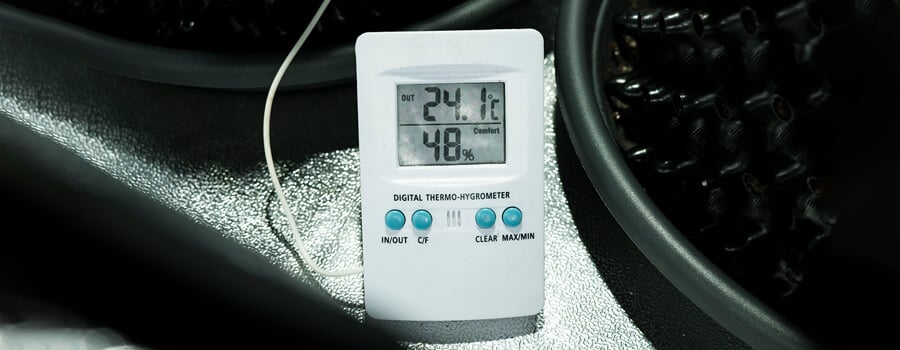
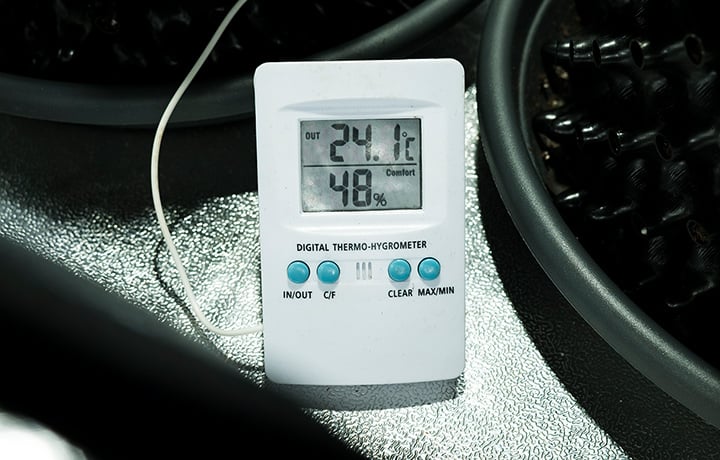
How to Increase Humidity in a Grow Tent
High humidity is a common issue, but sometimes the humidity can become too low as well. In these instances, you’ll need to raise the RH in the grow space if you want your plants to perform optimally.
-
Causes of Low Humidity
The following are often responsible for low humidity in a cannabis grow tent:
- Excessive heat from lighting systems: Too much heat can dry out a grow tent.
- Underwatering: Too little water means that there is insufficient moisture in the air.
-
Proven Methods
If the RH is too low in your grow space, the following methods can help you to remedy it:
- Humidifiers: These add moisture directly into the air and as such provide an immediate remedy.
- Water trays or wet towels: These are cost-effective methods to increase localised humidity.
- Light adjustments: Reduce the intensity of your lights to retain more moisture in the air. Also, keep in mind that HID lights tend to generate a lot more heat than LEDs, so consider the latter if you’re worried about excessive heat in your grow tent.
-
Monitoring Adjustments
It’s important to monitor the environment to ensure that the RH sits at the desired level, and that it doesn’t have any unintended consequences. Here are some suggestions:
- Use hygrometers to ensure adjustments meet plant requirements.
- Regularly check for any signs of mould or water stress.
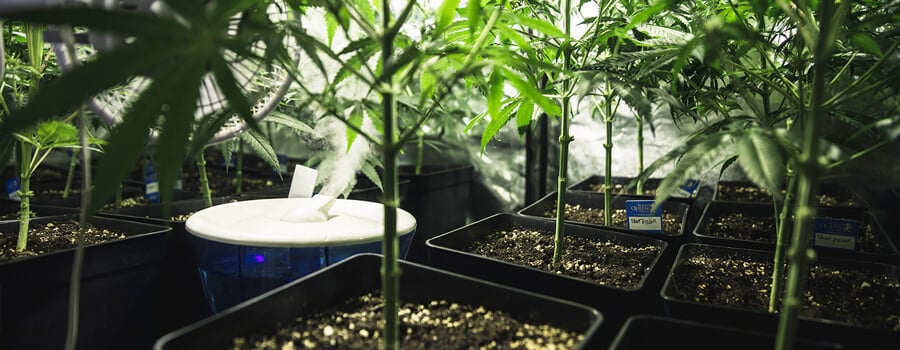
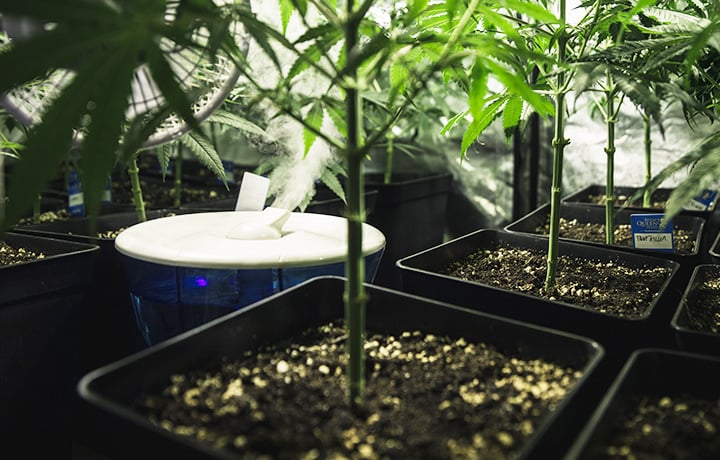
Grow Tent Temperature Control
You’ll also need to monitor and control the temperature within the grow tent. This goes hand in hand with humidity, and indeed they should be treated as two sides of the same coin.
-
How to Keep the Temperature Down in a Grow Tent
Overheating in grow tents is a common problem, although it’s becoming less of an issue as more people switch to LED lights over HIDs. Here are some tips for lowering the temperature in a grow space:
- Ventilation systems: Instal exhaust fans to expel hot air and draw in fresh air. These can also be automated.
- Use LED lights: These run much cooler compared to other options and shouldn’t cause overheating.
- Position fans to direct airflow towards hot spots: This will help to circulate air and keep the hottest pockets from getting too hot.
- Run grow lights during cooler hours: Doing so will mean the wider environment has a cooling effect.
- Insulate the tent to avoid external heat: This is suitable if the tent is situated somewhere where the outside is hotter than the inside. A highly insulated tent will also struggle to lose heat though, so bear this in mind.
-
How to Heat a Grow Tent
You may also want to heat your grow tent. With LEDs, it’s more important to understand how to do this, as the lights won’t do it for you! Here are some solutions:
- Use electric heaters with thermostats for precise control.
- Use heat mats for targeted root warming.
- Use circulating fans to evenly distribute heat evenly.
- Monitor frequently to avoid overheating.
-
Troubleshooting Overheating in Grow Rooms
If you’re running into heating-related issues in the grow room, here’s what you should investigate:
- Identify hot spots: These will likely be caused by excessive lighting or poor airflow. Poor airflow could also be the result of plants that are too close together.
- Adjust light height and fan placement: This will move the heat source further from your plants and improve airflow.
- Regularly clean vents and filters for optimal performance: Unclean filters will reduce airflow, which will increase both heat and humidity.
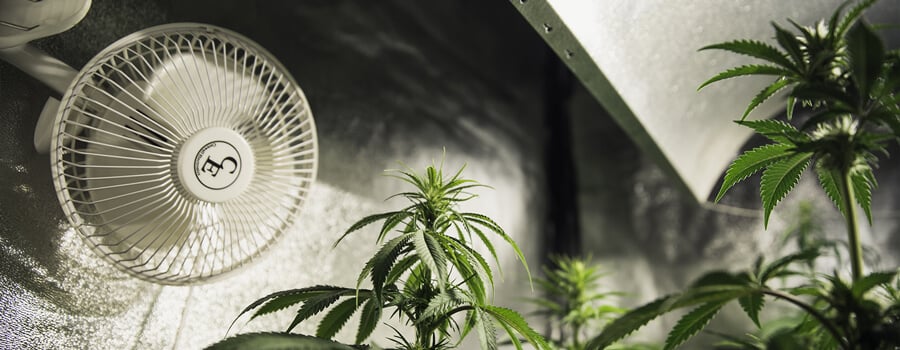
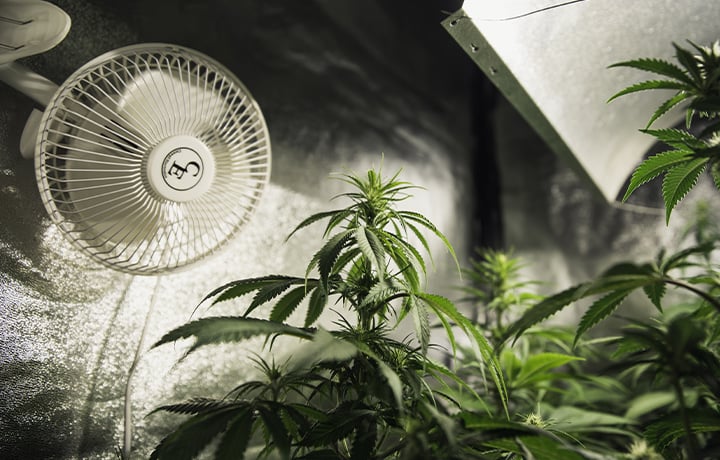
Advanced Tips for Temperature and Humidity Management
Most of the information listed above is compulsory even for simple grows. However, if you’re an experienced grower and want to optimise everything still further, there’s more you can do. The following section outlines some advanced tips for managing temperature and humidity.
-
Using a Grow Room Temperature and Humidity Chart
As noted, different stages of a grow necessitate different temperature and humidity levels. To give your plants what they really want, it can be very helpful to consult a specific temperature and humidity chart, also known as a vapor pressure deficit (VPD) chart. Using the colour-coded zones on your chart, you can determine the ideal temperature and humidity for every point during each stage of development. Here are some tips:
- Track and adjust levels daily based on the growth stage.
- Use automated systems to maintain stable conditions.
-
CO₂ and Environmental Optimisation
If plants have access to more CO₂, then you can increase the temperature and RH beyond normal levels. However, if you supplement with CO₂, be sure to ventilate the space well enough that it doesn’t become too concentrated.
Ultimately, the best results will arise when you optimise the environment, and that means achieving a balance between all of the different factors.
Temperature and Humidity: Two Key Metrics in Cannabis Growing
Temperature and humidity are key to a healthy and productive grow. Get them wrong, and you might not even make it to harvest. However, get them right, and you’ll have healthy plants that deliver in abundance!
It may seem complex, but once you get your grow set up, you’ll soon find it quite intuitive. Using meters, monitors, and even automated systems can make your life easier and will save you a lot of time. And once you’ve mastered the basics, consider some advanced techniques like VPD charts for even better results.
FAQ About Grow Tent Temperature and Humidity
- What temperature should my grow tent be?
- Day: 22–28°C (72–82°F). Night: 18–22°C (64–71°F).
- What humidity should my grow tent be at?
- 40–70% RH, depending on the growth stage.
- How do I stop my grow room from overheating?
- Improve ventilation, adjust lighting, and monitor heat sources.
- What tools do I need to manage temperature and humidity effectively?
- Hygrometers, thermostats, fans, dehumidifiers, and humidifiers.


























